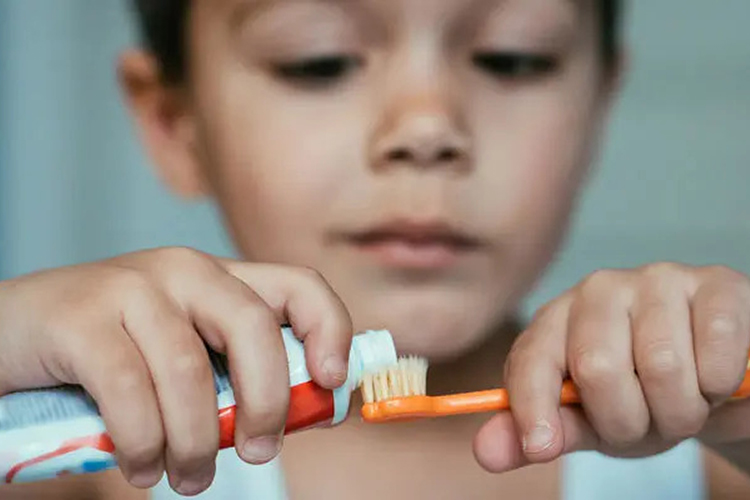Mississauga families have many toothpaste choices for their children and finding the right one for your child is critical to their overall oral health.
Here we will outline the considerations you may wish to make when choosing the best toothpaste for your child.
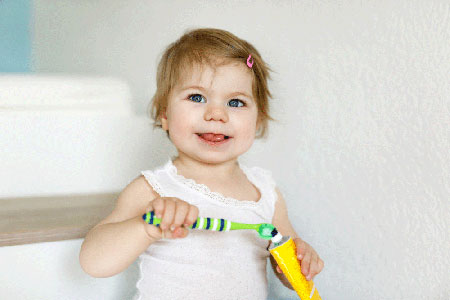
Deciding between a fluoride or non-fluoride-based toothpaste for your child.
Adding Floride to toothpaste helps strengthen your dentition. Fluoride is an element that is omnipresent on earth. Its ingestion can help your teeth by:
- Preventing cavities
- Strengthening tooth enamel
- Reversing early stages of tooth decay
- Limiting plaque bacteria in the mouth
- Slowing mineral loss in tooth enamel
- Echinacea
- American ginseng
- Ginkgo
- Golden Seal Root
- St. Lawrence Dentistry Looks Forward To St. Patrick’s Day! - March 12, 2025
- Understanding Dental X-Rays and Radiation: What You Should Know - January 13, 2025
- Happy New Year from St. Lawrence Dentistry! - December 30, 2024
<.ul>
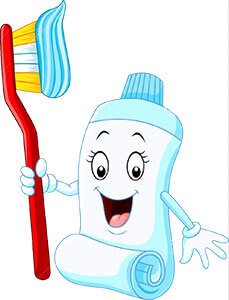
The Canadian dental association says for children from birth to 3 years of age, you should determine the need for fluoridated toothpaste by the level of probability of tooth decay. Parents can consult with St. Lawrence Dentistry to see whether their child is at risk of having dental caries. If there is a risk, the child’s teeth should be brushed by a parent/adult using a tiny amount (the size of a rice grain) of fluoridated toothpaste. The use of fluoridated toothpaste in small amounts balances fluoride benefits and the risk of developing fluorosis. If the child is not at risk, an adult should clean the child’s teeth with a toothbrush that is only water moistened.
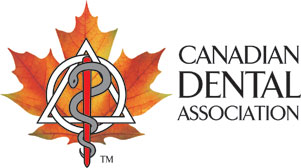
From 3-6 years of age, children should only use a tiny portion (green pea size) of fluoridated toothpaste. An adult should assist children in this age group in brushing their teeth. Younger children tend to swallow toothpaste when they are brushing, which may increase their fluoride exposure and lead to dental fluorosis. Dr. Hawryluk recommends you assist or supervise your child. An adult needs to ensure the use of the appropriate quantity of toothpaste, that the child is brushing effectively, and expectorates the toothpaste rather than swallowing it.
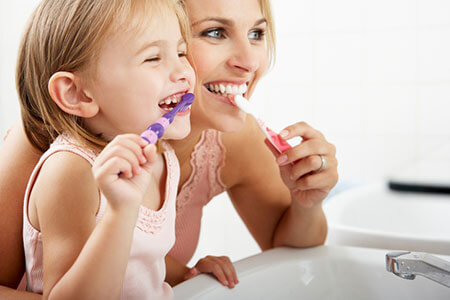
https://images.app.goo.gl/kzGRFWU9QFXAZnpK7
St. Lawrence Dentistry recommends monitoring your child’s brushing until they have mastered it and know to expectorate toothpaste. Many children become proficient at brushing by themselves, usually around age 6 or 7. If children ingest a more significant amount of fluoride toothpaste, they might experience an upset stomach. If your child feels unwell after toothpaste ingestion, please get medical advice. The Canadian government website recommends children age 3 to 6 should have an adult clean their teeth using only a tiny amount (small green pea-sized) of fluoridated toothpaste. Once your child is six years old and has evolved the ability to expectorate toothpaste, they can start supervised tooth brushing using toothpaste that contains fluoride.
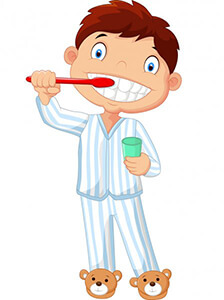
Should toddlers use Fluoride toothpaste?
It’s natural to be worried about toddlers ingesting toothpaste fluoride-containing or not. Most toddlers have a functional spit reflex around 3-4 years of age. Children younger than this age usually cannot brush their teeth on their own. You can limit any chance of ingestion by merely using a “smear” of dentifrice, about the size of a rice grain, when you first start brushing your baby’s teeth. Parents who are anxious about managing how much fluoride their child intakes can use a toothpaste that is fluoride free. The Canadian government website says Infants and toddlers age 0 to 3 (36 months) at risk of developing tooth decay should have their teeth brushed by an adult using a minimal amount (rice-sized grain) of fluoridated toothpaste. If your child is under three, we recommend consulting Dr. Hawryluk to determine whether your child is prone to developing dental caries.
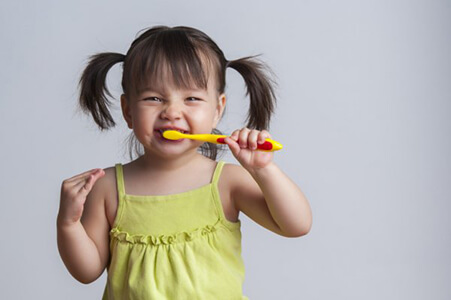
What is the best type of dentifrice for children?
Babies and children may require special toothpaste. The fluoride concentration is higher in adult toothpaste. Another difference is adult toothpaste tends to be more abrasive and has more robust flavors.
Many adults use whitening toothpaste; however, using whitening toothpaste for kids isn’t a good idea. These toothpaste types are more abrasive on the teeth and could erode the enamel of a child’s teeth, as children’s teeth have thinner enamel. If your child’s teeth are darker or tinted in some areas, assess their diet for intensely colored foods and speak with one of our friendly attendants at St. Lawrence Dentistry if you have concerns.
What is the best baby toothpaste (0-2 years)?
When a baby’s teeth first appear, it’s essential to clean them two times daily to safeguard against cavities. The American Dental Association now recommends using fluoride toothpaste with your toddler and older children (albeit a minimal amount). Despite this, many parents want a brand for their child which does not contain fluoride. Another prominent organization, the American Academy of Pediatrics, recommends a tiny smear of fluoride toothpaste when teeth first erupt. These recommendations are a 2014 update to former guidelines, which had suggested using fluoride-free toothpaste until children reach the age of 2. To reduce the chance of swallowing, try tilting your children’s head slightly downward so the extra paste “dribbles out” of their mouth.

Natural baby toothpaste
Radius makes an organic fluoride-free option for children. Their cheerful slogan is “Squeaky Clean, Great Flavor”. There are no chemicals or nasty additives. It touts ingredients like coconut oil, rice powder, and cavity-shielding “erythritol” (a safe alternative to fluoride). Radius says their kid’s toothpaste is the best natural toothpaste not only because of the organic ingredients but because it comes in two great flavors kids love – Coconut Banana and Dragon Fruit. Since it’s non-toxic, your child should be fine if a small amount inadvertently gets swallowed. Its coconut banana flavor is a real ‘hit’ among children. Both babies and adolescents can use this paste.
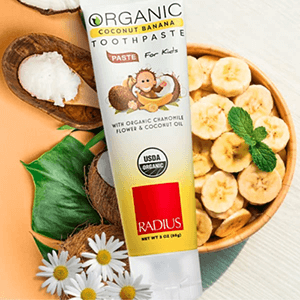
Tom’s baby toothpaste
Kids love the natural fruit flavor of this popular children’s toothpaste. A popular flavor is their Silly Strawberry. Its slogan is “Silly Enough for Kids – Good Enough for Moms and Dads!” Their toothpaste for children uses calcium and silica to gently clean, and the delicious authentic fruit flavor appeals to children’s taste preferences. There are no artificial flavors, no animal ingredients, and there is no testing on animals. To ‘top it off, it comes in a recyclable tube. It suitable for the age range of 3-24 months, and it is fluoride-free. It’s safe even if a toddler ingests a small amount. It has a “no-mess top”, and its mild fruit flavor is ‘delightful.’ It’s an excellent toothpaste for your child to ‘practice brushing’ before moving on to a fluoride-based paste.
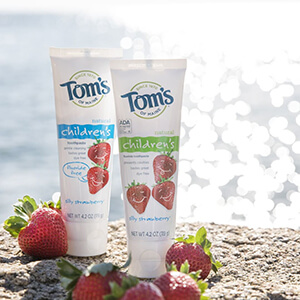
Weleda baby toothpaste
Weleda makes one of the best natural toothpaste for kids and babies.
Weleda is based in Switzerland and makes plant-based wellbeing and health products. Their Children’s Tooth Gel takes care of primary teeth. The company says that its “calendula flower extract” and “silica infusion” help keep gums clean. Teeth cleaning can be a happy experience; for children due to the tasty fennel and spearmint flavors. Weleda states that the paste has are no ingredients that are harmful if swallowed. It’s “everything good” you want for your child’s early teeth. It’s a gentle, effective cleanser with pleasant-tasting, essential oils. Silica gently cleans teeth and makes them feel refreshed. It does not contain any fluoride sugar, artificial sweeteners, surfactants, synthetic preservatives, colorants, or raw materials derived from mineral oils. There are no harmful ingredients if swallowed. It is certified natural by NATRUE.
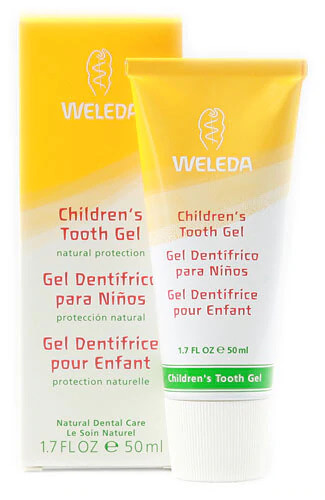
What’s the finest dentifrice for children aged three to six?
As your child grows, they should be capable of spitting better, and the chances of them swallowing toothpaste will diminish. You’ll also want to consider changing from a fluoride-free toothpaste for children to one that includes fluoride. However, at this age, you should still oversee them as they brush and help them learn how to brush correctly.
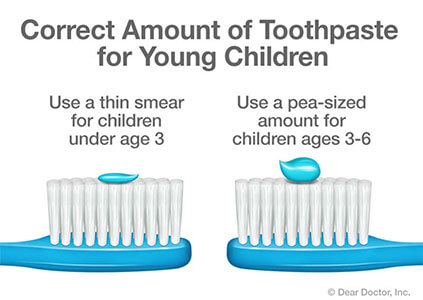
Colgate kids’ toothpaste
The best youngsters’ toothpaste might vary on what flavor your little one likes. Colgate Kids Cavity Protection Toothpaste is a fluoride-based toothpaste for children with a fruity, ‘bubble’ gum flavor—great for kids who are not into a mint taste. Colgate Fluoride toothpaste for Kids contains an enamel-safe formula proven to fight cavities. This formulation, specially designed for kids ages two and up, also strengthens and protects developing teeth. With a mild bubble fruit flavor, the Colgate toothpaste design is with fun characters on a practical ‘stand-up’ tube with a flip-top cap that encourages kids to brush.
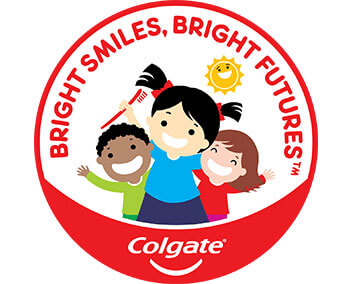
Crest kids’ toothpaste
The best toothpaste for kids will have a safeguard against cavities.
A non-mint children’s toothpaste with fluoride is Crest kid’s cavity protection toothpaste. It tastes like bubble gum, and we recommend it for children two and above. Kid’s Crest Cavity Protection dentifrice’s fun sparkles encourages daily brushing and makes it enjoyable. Plus, your children will be combating cavities with research-proven ‘Fluoristat’ that’s gentle on tooth enamel. The Fun-filled sparkles and Sparkle Fun flavor for kids make it brushing enjoyable.

Coral kids’ toothpaste
For the socially conscious purchaser, who is also looking for a children’s toothpaste without fluoride, Coral White kids toothpaste may be just the ticket. This toothpaste is innovative, as it utilizes coral calcium from coral, which offers seventy-four natural minerals that facilitate the creation of an ‘alkaline environment’ to kill bacteria and strengthen your child’s teeth and body. Try this socially conscious, natural toothpaste for kids. You’ll be delighted to know that the makers of Coral White use the above sea fossilized coral beds to collect their coral calcium. Hence, there is no injury to the ocean by coral harvesting. What’s more, this toothpaste uses xylitol as a natural sweetener, keeping a neutral pH level in the mouth and repairs enamel.
This toothpaste also includes the herbal infusions of:
These extracts have antibacterial qualities that assist as a natural way to fight periodontal disease.
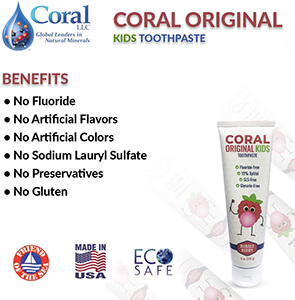
The best kids’ toothpaste for ages seven-plus
At the age of seven, many children have complete control over their ability to swallow control their motor functions. At this milestone, Dr. Hawryluk says that you may be able to leave them to brush their teeth by themselves. And again, if you haven’t been using a fluoride toothpaste for kids, you may want to think about starting. While it is acceptable for them to use a “pea” portioned quantity of regular toothpaste, they may still prefer a more child-friendly option.
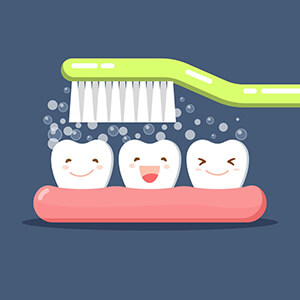
Firefly natural toothpaste for kids
Firefly natural kids’ toothpaste is newer market addition for kids’ natural toothpaste but is already a parent and child preference. This toothpaste ‘covers the basics’ with 0.24% fluoride for defending against cavities, but then it goes a measure further, with 98% naturally procured ingredients. There are no unnatural sweeteners, no synthetic flavors, and no colorants, making this a contender for ‘kids’ most suitable toothpaste’ and ‘the best natural toothpaste for kids. It’s ideal for youngsters aged 3+. This toothpaste comes with kids’ favorite characters on the outside and ‘Bubble Blast, Strawberry Smoothie, or Wild Watermelon’ tastes on the inside. And the best part? There’s a mystery trinket hidden under the lid of each one!
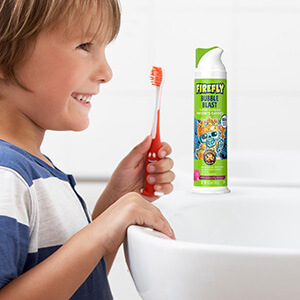
Conclusion
It’s vital to find the best kids’ toothpaste for your child’s oral health.
Every guardian wants what’s most suitable for their child’s teeth, and choosing the best children’s toothpaste an essential step in achieving that goal. Although sensibly, you’ll want to investigate fluoride-free toothpaste for your kids, scientists and dentists recognize that fluoride is helpful to teeth and shouldn’t cause any harm if used rightly. Ensure that you encourage your kids to use their toothpaste correctly until they’re mature enough to look after their teeth themselves. By choosing qualities that they like, you will keep them wanting to brush, and by picking the proper fluoride levels, you’ll make sure they shield themselves from cavities while waiting for their adult teeth to come through.
Reference:
https://www.healthline.com/health/fluoride-toothpaste
https://www.healthychildren.org/English/healthy-living/oral-health/Pages/Toothbrushing-Tips-for-Young-Children.aspx



